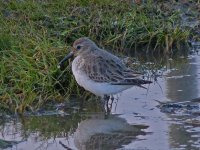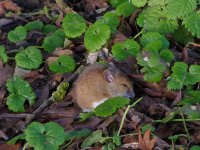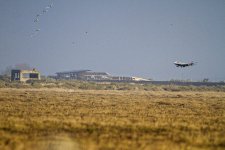I suspect the majority of unusual geese found in Norfolk are escapes or feral birds.
I am not sure about the present Ross goose at Kelling , but the 2 Ross geese that were ( one still is ) with the pink feet on the coast originate from Pensthorpe where they held free winged birds some years ago that used to disappear from Pensthorpe at the time Ross geese were seen with the pinks on the coast only to reappear at Pensthorpe at a time when they could not be found along the coast. After several years of this pattern 2 birds joined the pink feet as permanent flock members and migrated with them. One paired with a pink foot and produced hybrid goslings and the other was found dead on the shore next to a pink foot roost.
Hi Tideliner, this is an interesting revelation. I'd heard rumours to this effect before but lacking the detail. Perphaps the rumours originated from your observations...
Can you clarify the dates of what you're talking about here? The first Ross's Goose among the Pink-feet that I recall was the first-winter bird that arrived in November 2001, and that remained with the Pink-feet continuously so far as I know. When were the two birds you refer to commuting between the Pink-foot flocks on the north coast and Pensthorpe? Was that before the first-winter bird turned up in 2001, or did it include that bird?
An adult Ross's reappeared the following winter, which I assumed to be the same returning bird, and then in 2003/04 I saw a total of 3 Ross's Geese among the Pink-feet. I am not aware of any sightings of two of these apart from the Pink-foot flocks, but the third bird was a blue plastic-ringed bird that spent the majority of its time with feral geese. This bird only joined the Pink-footed Geese temporarily - for no more than 2-3 days as far as I know. It wouldn't surprise me if this bird came from Pensthorpe, or even commuted between Pensthorpe and the north coast, but I don't believe it migrated with Pink-footed Geese.
I didn't see any Ross's Geese with the Pink-feet the following winter, though I don't recall if anyone else did, nor the following winter (the bird reports don't make it clear that any were present with the Pink-feet during those winters).
A Ross's Goose appeared in 2007/08. This bird was, I assume, a different bird as it had several black secondaries which I don't think were present on the earlier birds. It was also seen migrating with Pink-feet elsewhere in the UK. One was present the following winter, though spending most of its time in the east of the county I didn't see it often. I don't recall any present last winter, but one has appeared again this winter (I've not seen it yet).
Part of the difficulty with assessing these is that the Pink-footed Goose flocks when they're on the coast (and sometimes when they're inland, e.g. at Flitcham) will often share the same fields as feral geese, and then people see them together and draw conclusions. In my experience it is actually extremely unusual for feral geese to stay with the wild goose flocks for any length of time. I have frequently watched the goose flocks feeding inland near my workplace and apart from vagrant geese of uncertain origin I have seen the following individually identifiable geese on multiple occasions:
- various neck-collared Pink-feet
- various leucistic or otherwise aberrant Pink-feet
- the hybrid goose, presumed Pink-foot x Ross's
- a Pale-bellied Brent Goose (surely the same one each time as it's at the greyer-bellied end of the variation in Pale-bellied)
- several adult Greenland White-fronted Geese (with indvidually unique belly markings)
Each of these I've seen on multiple occasions, mostly at multiple sites and often in multiple winters. Each of them is either obviously or likely to be wild origin. On the other hand I have NEVER seen an obviously feral or escaped bird of ANY type with the Pink-footed Geese and away from where feral geese normally frequent on multiple occasions.
Away from sites that normally have feral geese present regardless of whether there are Pink-feet in the area, I've only seen large-race Canada Geese (i.e. obviously feral ones) and Egyptian Geese on one occasion each. At the coast, and at places like Flitcham, it's not uncommon to see these species among Pink-feet, because they happen to be in the same field, but inland away from places normally frequented by feral geese the Pink-foot flocks contained only Pink-feet and, sometimes, birds that at least MIGHT be wild.
There certainly are a few Ross's Geese around which are very probably of escaped origin, but I've personally not seen any evidence that these are linked to the spate of sightings of apparently wild and migrating birds that remain with Pink-feet. Personally I'm open minded and don't care much whether I'm allowed to tick them or not, but I find it much easier to believe they're wild than not. If feral and escaped birds to habitually join up with, and stay with, wild Pink-footed Geese, then why don't Egyptian Geese and large Canada Geese do that? Why's it only the ones that are quite likely to occur here in a natural state?






